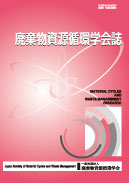Volume 24, Issue 6
Displaying 1-15 of 15 articles from this issue
- |<
- <
- 1
- >
- >|
Preface
-
2013Volume 24Issue 6 Pages 401-402
Published: November 30, 2013
Released on J-STAGE: March 20, 2021
Download PDF (202K)
Special Issues : Now is the Time to Reconsider “Disaster Debris Treatment Plan” in Japan that has a Lot of Earthquakes
-
2013Volume 24Issue 6 Pages 403-405
Published: November 30, 2013
Released on J-STAGE: March 20, 2021
Download PDF (216K) -
2013Volume 24Issue 6 Pages 406-414
Published: November 30, 2013
Released on J-STAGE: March 20, 2021
Download PDF (686K) -
2013Volume 24Issue 6 Pages 415-419
Published: November 30, 2013
Released on J-STAGE: March 20, 2021
Download PDF (412K) -
2013Volume 24Issue 6 Pages 420-424
Published: November 30, 2013
Released on J-STAGE: March 20, 2021
Download PDF (440K) -
2013Volume 24Issue 6 Pages 425-433
Published: November 30, 2013
Released on J-STAGE: March 20, 2021
Download PDF (3449K) -
2013Volume 24Issue 6 Pages 434-441
Published: November 30, 2013
Released on J-STAGE: March 20, 2021
Download PDF (780K) -
2013Volume 24Issue 6 Pages 442-448
Published: November 30, 2013
Released on J-STAGE: March 20, 2021
Download PDF (2415K) -
2013Volume 24Issue 6 Pages 449-455
Published: November 30, 2013
Released on J-STAGE: March 20, 2021
Download PDF (444K) -
2013Volume 24Issue 6 Pages 456-465
Published: November 30, 2013
Released on J-STAGE: March 20, 2021
Download PDF (1074K)
Introductory Course / Introduction of Physics and Chemistry for Material Cycles and Waste Management 3 :
-
2013Volume 24Issue 6 Pages 466-471
Published: November 30, 2013
Released on J-STAGE: March 20, 2021
Download PDF (1011K)
Report on 25th Annual Symposium hosted by JSMCWM
-
2013Volume 24Issue 6 Pages 472-475
Published: November 30, 2013
Released on J-STAGE: March 20, 2021
Download PDF (1112K)
Report of the JSMCWM Research Division
-
2013Volume 24Issue 6 Pages 476-477
Published: November 30, 2013
Released on J-STAGE: March 20, 2021
Download PDF (193K)
Activity Report from the Regional Chapter
-
2013Volume 24Issue 6 Pages 478-479
Published: November 30, 2013
Released on J-STAGE: March 20, 2021
Download PDF (310K)
Book Review
-
2013Volume 24Issue 6 Pages 480
Published: November 30, 2013
Released on J-STAGE: March 20, 2021
Download PDF (130K)
- |<
- <
- 1
- >
- >|
